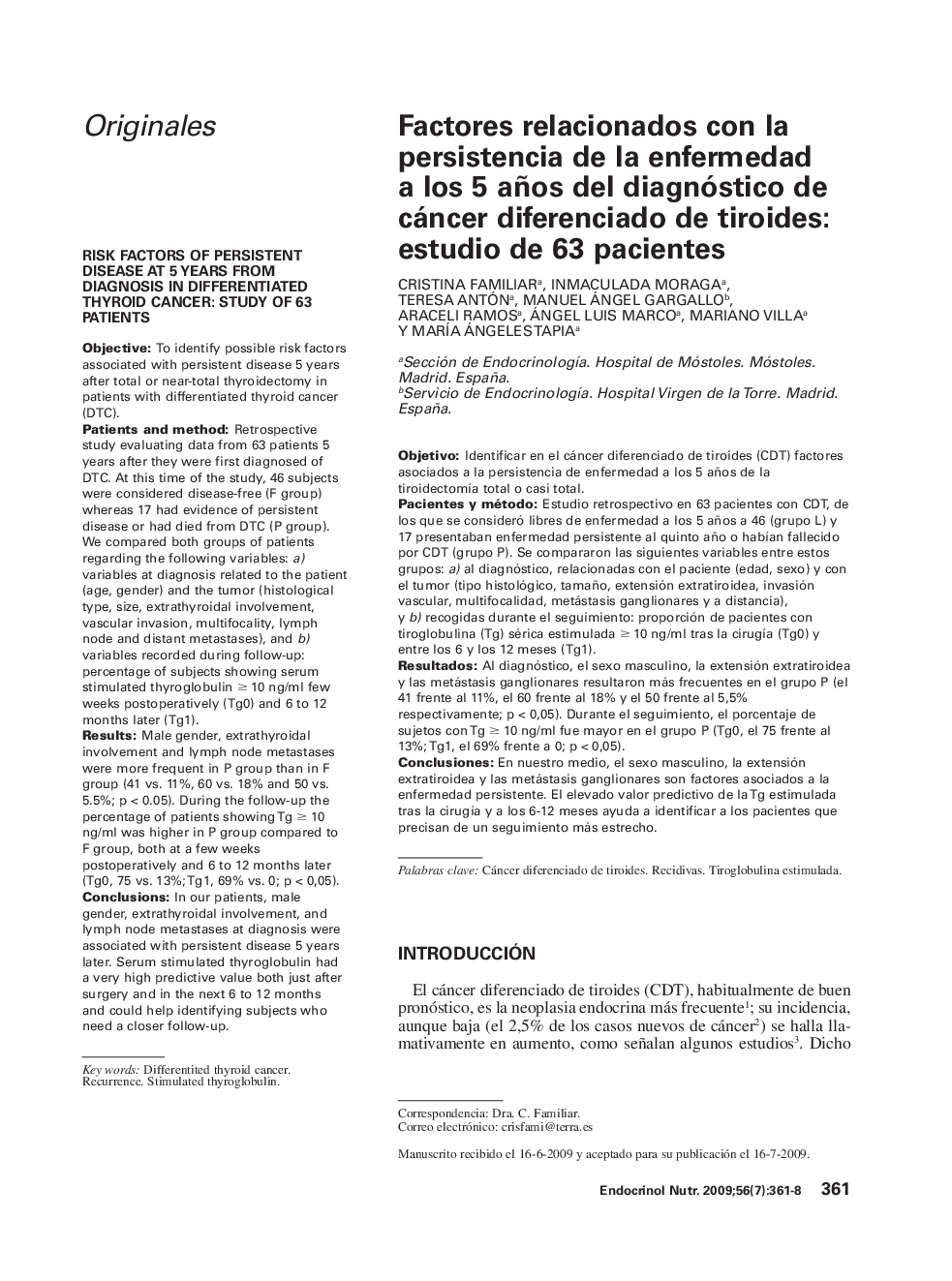| Article ID | Journal | Published Year | Pages | File Type |
|---|---|---|---|---|
| 2773944 | Endocrinología y Nutrición | 2009 | 8 Pages |
ObjetivoIdentificar en el cáncer diferenciado de tiroides (CDT) factores asociados a la persistencia de enfermedad a los 5 años de la tiroidectomía total o casi total.Pacientes y métodoEstudio retrospectivo en 63 pacientes con CDT, de los que se consideró libres de enfermedad a los 5 años a 46 (grupo L) y 17 presentaban enfermedad persistente al quinto año o habían fallecido por CDT (grupo P). Se compararon las siguientes variables entre estos grupos: a) al diagnóstico, relacionadas con el paciente (edad, sexo) y con el tumor (tipo histológico, tamaño, extensión extratiroidea, invasión vascular, multifocalidad, metástasis ganglionares y a distancia), y b) recogidas durante el seguimiento: proporción de pacientes con tiroglobulina (Tg) sérica estimulada ≥ 10 ng/ml tras la cirugía (Tg0) y entre los 6 y los 12 meses (Tg1).ResultadosAl diagnóstico, el sexo masculino, la extensión extratiroidea y las metástasis ganglionares resultaron más frecuentes en el grupo P (el 41 frente al 11%, el 60 frente al 18% y el 50 frente al 5,5% respectivamente; p < 0,05). Durante el seguimiento, el porcentaje de sujetos con Tg ≥ 10 ng/ml fue mayor en el grupo P (Tg0, el 75 frente al 13%; Tg1, el 69% frente a 0; p < 0,05).ConclusionesEn nuestro medio, el sexo masculino, la extensión extratiroidea y las metástasis ganglionares son factores asociados a la enfermedad persistente. El elevado valor predictivo de la Tg estimulada tras la cirugía y a los 6-12 meses ayuda a identificar a los pacientes que precisan de un seguimiento más estrecho.
ObjectiveTo identify possible risk factors associated with persistent disease 5 years after total or near-total thyroidectomy in patients with differentiated thyroid cancer (DTC).Patients and methodRetrospective study evaluating data from 63 patients 5 years after they were first diagnosed of DTC. At this time of the study, 46 subjects were considered disease-free (F group) whereas 17 had evidence of persistent disease or had died from DTC (P group). We compared both groups of patients regarding the following variables: a) variables at diagnosis related to the patient (age, gender) and the tumor (histological type, size, extrathyroidal involvement, vascular invasion, multifocality, lymph node and distant metastases), and b) variables recorded during follow-up: percentage of subjects showing serum stimulated thyroglobulin ≥ 10 ng/ml few weeks postoperatively (Tg0) and 6 to 12 months later (Tg1).ResultsMale gender, extrathyroidal involvement and lymph node metastases were more frequent in P group than in F group (41 vs. 11%, 60 vs. 18% and 50 vs. 5.5%; p < 0.05). During the follow-up the percentage of patients showing Tg ≥ 10 ng/ml was higher in P group compared to F group, both at a few weeks postoperatively and 6 to 12 months later (Tg0, 75 vs. 13%; Tg1, 69% vs. 0; p < 0,05).ConclusionsIn our patients, male gender, extrathyroidal involvement, and lymph node metastases at diagnosis were associated with persistent disease 5 years later. Serum stimulated thyroglobulin had a very high predictive value both just after surgery and in the next 6 to 12 months and could help identifying subjects who need a closer follow-up.
